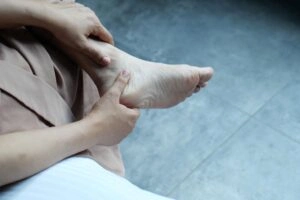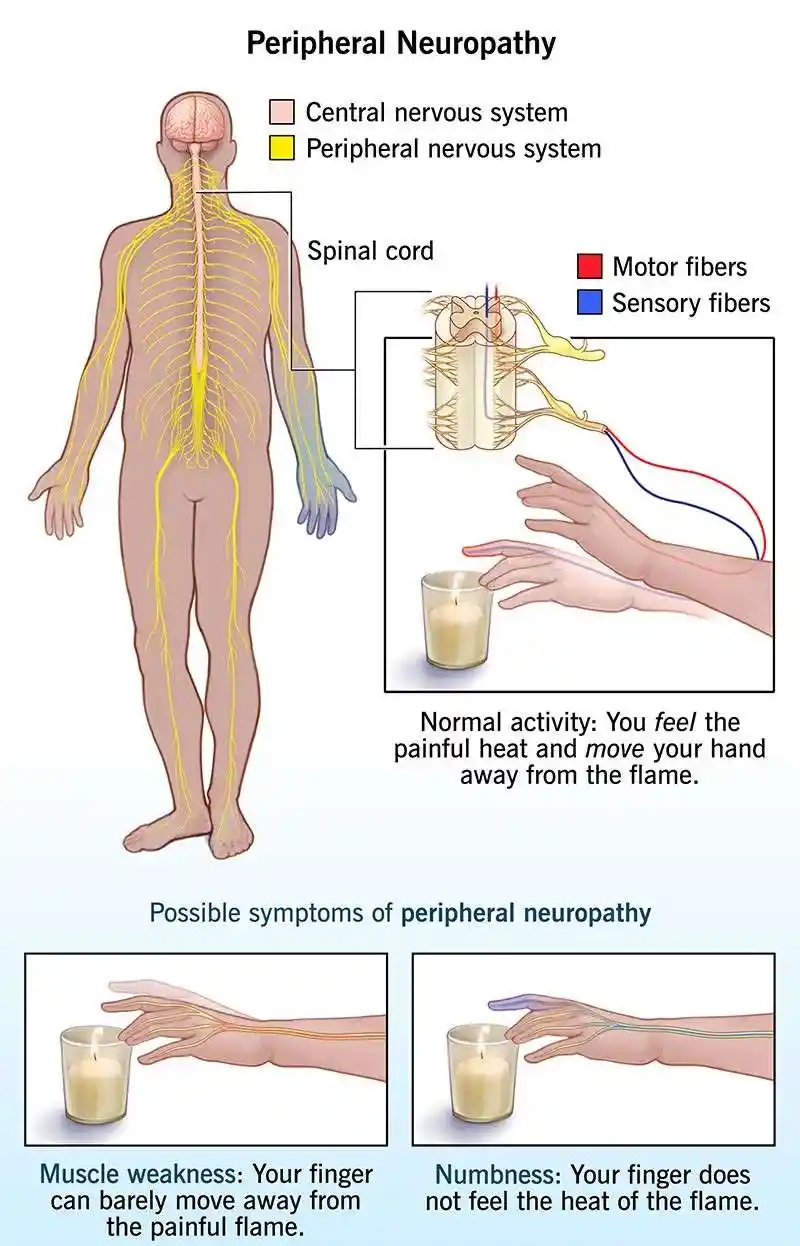
Peripheral Neuropathy: Symptoms, Causes, and Diagnosis
Peripheral Neuropathy: Symptoms, Causes, and Diagnosis
Key takeaways
- More than 20 million Americans live with peripheral neuropathy, which can significantly impact mobility, sensation, and quality of life.
- Key contributors include diabetes (affecting 60–70% of individuals with diabetes in the U.S.), chemotherapy-induced nerve damage b, alcohol abuse, vitamin deficiencies, autoimmune diseases, and chronic kidney disease.
- Common signs include tingling, numbness, burning pain, muscle weakness, and difficulty walking or balancing—symptoms often begin in the hands or feet.
- Early diagnosis involves a combination of medical history, physical exams, and tests like nerve conduction studies or electromyography.
- Treatment options include medications, lifestyle changes, physical therap
Peripheral neuropathy affects an estimated 20 million Americans—it’s a widespread condition with significant impacts on quality of life. This disorder damages the peripheral nerves, which transmit signals between the brain, spinal cord, and other parts of the body. When peripheral nerve damage occurs, individuals may experience symptoms like pain, tingling, numbness, or muscle weakness, often starting in the hands or feet.
Understanding the symptoms and identifying the underlying causes is essential for early diagnosis and management.
Understanding peripheral neuropathy

- Sensory neuropathy: Affects nerves that transmit sensory information. Symptoms include tingling, burning, numbness, or sensitivity to touch.
- Motor neuropathy: Impacts nerves responsible for muscle movement. Symptoms include muscle weakness, cramping, or difficulty with coordination.
- Autonomic neuropathy: Impacts nerves responsible for controlling functions like digestion, blood pressure, and heart rate. Symptoms include dizziness, digestive issues, or problems regulating temperature.
- Combination neuropathy: Involves a mix of sensory, motor, and autonomic nerve damage. Symptoms may vary widely depending on the nerves affected.
- Autoimmune peripheral neuropathy: Occurs when the immune system attacks the peripheral nerves by mistake, as seen in conditions like Guillain-Barré syndrome or chronic inflammatory demyelinating polyneuropathy (CIDP). Symptoms may include weakness, numbness, or pain, often progressing over time.
Common symptoms of peripheral neuropathy
Peripheral neuropathy doesn’t announce itself with a single, obvious symptom. Instead, it often starts subtly, making it easy to overlook. Over time, the symptoms can worsen, becoming harder to ignore.
General symptoms
Imagine trying to walk on a sandy beach but feeling as though your feet are still in shoes—numb, tingling, or disconnected from the ground beneath you. That’s one of the hallmark signs of peripheral neuropathy—tingling or numbness that often starts in the hands and feet and gradually spreads upward.
Other common symptoms include:
Burning or stabbing pain: A sharp, shooting pain can strike unexpectedly, making even resting uncomfortable.
Muscle weakness or coordination issues: Tasks that once felt effortless—like gripping a pen or climbing stairs—become harder as muscles weaken and coordination declines.
Symptoms specific to feet and legs
The feet are often the first to feel the effects of peripheral neuropathy. That’s because the longest nerves, which extend to the extremities, are most susceptible to damage. Over time, you may notice:
Loss of sensation: Walking barefoot may feel strange or even dangerous, as you lose the ability to sense hot or sharp objects.
Sensitivity to touch: Even the lightest pressure, like a bedsheet brushing against your skin, may trigger discomfort or pain.
Difficulty walking or balancing: As numbness or weakness progresses, staying steady on your feet becomes a daily challenge.
For some, these symptoms come and go; for others, they’re persistent and debilitating. Recognizing them early can make all the difference in seeking effective treatment and preserving quality of life.
Causes of peripheral neuropathy
- Diabetes mellitus: Chronic high blood sugar levels damage nerves and blood vessels supplying them, leading to sensory loss and pain, especially in the feet.
- Chemotherapy-induced peripheral neuropathy (CIPN): Certain chemotherapy agents are neurotoxic, causing nerve damage that results in pain, tingling, and numbness in the extremities.
- Alcohol abuse: Chronic alcohol consumption can lead to nutritional deficiencies and direct nerve toxicity, resulting in alcoholic neuropathy characterized by pain and sensory disturbances in the feet.
- Vitamin deficiencies: Deficiencies in vitamins such as B12, B6, and E can impair nerve function, leading to symptoms like numbness and tingling in the feet.
- Autoimmune diseases: Conditions like Sjögren’s syndrome, lupus, and rheumatoid arthritis can cause the immune system to attack peripheral nerves, resulting in neuropathic symptoms.
- Toxins and medications: Exposure to heavy metals (e.g., lead, mercury) and certain medications, including some used to treat HIV/AIDS, can cause toxic neuropathy affecting the feet.
- Chronic kidney disease: Accumulation of toxins due to kidney failure can damage peripheral nerves, leading to uremic neuropathy with symptoms in the lower extremities.
- Idiopathic neuropathy: Approximately 25-46% of peripheral neuropathy cases have no identifiable cause and are termed idiopathic.

- Diabetes mellitus: Chronic high blood sugar levels damage nerves and blood vessels supplying them, leading to sensory loss and pain, especially in the feet.
- Chemotherapy-induced peripheral neuropathy (CIPN): Certain chemotherapy agents are neurotoxic, causing nerve damage that results in pain, tingling, and numbness in the extremities.
- Alcohol abuse: Chronic alcohol consumption can lead to nutritional deficiencies and direct nerve toxicity, resulting in alcoholic neuropathy characterized by pain and sensory disturbances in the feet.
- Vitamin deficiencies: Deficiencies in vitamins such as B12, B6, and E can impair nerve function, leading to symptoms like numbness and tingling in the feet.
- Autoimmune diseases: Conditions like Sjögren’s syndrome, lupus, and rheumatoid arthritis can cause the immune system to attack peripheral nerves, resulting in neuropathic symptoms.
- Toxins and medications: Exposure to heavy metals (e.g., lead, mercury) and certain medications, including some used to treat HIV/AIDS, can cause toxic neuropathy affecting the feet.
- Chronic kidney disease: Accumulation of toxins due to kidney failure can damage peripheral nerves, leading to uremic neuropathy with symptoms in the lower extremities.
- Idiopathic neuropathy: Approximately 25-46% of peripheral neuropathy cases have no identifiable cause and are termed idiopathic.
Diagnosing peripheral neuropathy
A timely and accurate diagnosis is essential for addressing the root cause of peripheral neuropathy and tailoring an effective treatment plan.
Diagnosing peripheral neuropathy
When to see a doctor
It’s important to seek medical attention if you experience any of the following symptoms:
Persistent or worsening numbness, tingling, or pain in your hands or feet
Loss of sensation that affects your ability to perform daily tasks
Muscle weakness or difficulty maintaining balance
Symptoms that appear suddenly or progress rapidly
Unexplained pain or discomfort, especially if accompanied by other health issues like diabetes or a history of alcohol abuse
Diagnostic process
To identify peripheral neuropathy and its underlying cause, doctors rely on a combination of medical history, physical exams, and specialized tests. Here’s what the process typically involves:
Medical history review
Assess symptoms (e.g., onset, duration, and progression).
Discuss underlying health conditions (e.g., diabetes, kidney disease, autoimmune disorders).
Evaluate lifestyle factors (e.g., alcohol use, exposure to toxins).
Review family history of neuropathy or related conditions.
Physical examination
Check muscle strength, reflexes, and coordination.
Test for loss of sensation using tools like tuning forks or monofilaments.
Diagnostic tests
Nerve conduction studies: Evaluate how effectively and quickly electrical signals move through nerves to identify any signs of damage.
Electromyography: Detect electrical activity in muscles to determine if symptoms are nerve-related.
Blood tests: Check for underlying causes such as diabetes, vitamin deficiencies, or thyroid issues.
Imaging tests: Use MRI or CT scans to detect structural causes, such as nerve compression.
Nerve biopsy (rare): Examine a small sample of nerve tissue under a microscope to confirm certain diagnoses.
Find out if you are a candidate
Managing and treating peripheral neuropathy
Peripheral neuropathy is a common but complex condition that affects millions, often starting with subtle symptoms like tingling or numbness in the hands and feet. Identifying the underlying cause—whether it’s diabetes, chemotherapy, or another factor—is essential for effective treatment.
Early diagnosis and a tailored management plan can significantly improve quality of life, making it crucial to seek medical advice if symptoms persist or worsen.
Peripheral neuropathy symptoms and diagnosis: Frequently asked questions
What causes neuropathy in the feet?
Neuropathy in the feet is commonly caused by damage to the peripheral nerves due to various factors, including diabetes, vitamin deficiencies, chemotherapy, alcohol abuse, and autoimmune diseases.
If you notice persistent pain, numbness, or tingling in your feet, it’s important to consult a healthcare provider for further evaluation.
What are the early signs of peripheral neuropathy?
The early signs of peripheral neuropathy include tingling or numbness in the hands or feet, burning or stabbing pain, increased sensitivity to touch, and weakness or difficulty coordinating movements. These symptoms often begin subtly but can progress over time if left untreated.
How is peripheral neuropathy diagnosed?
Peripheral neuropathy is diagnosed through:
- Medical history review: Identifying risk factors such as diabetes, alcohol use, or chemotherapy
- Physical exam: Testing reflexes, muscle strength, and sensation
- Diagnostic tests: Nerve conduction studies (NCS), electromyography (EMG), and blood tests to uncover underlying causes like vitamin deficiencies or thyroid issues
An early diagnosis can help prevent further nerve damage and guide treatment options.













